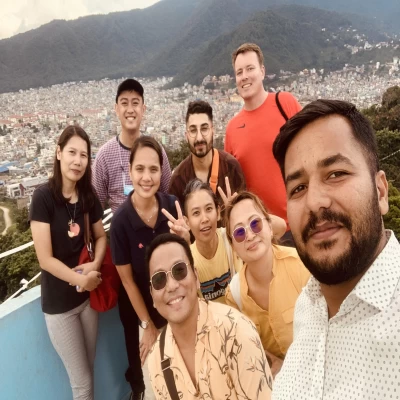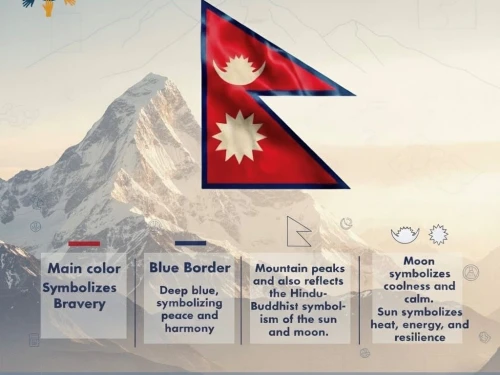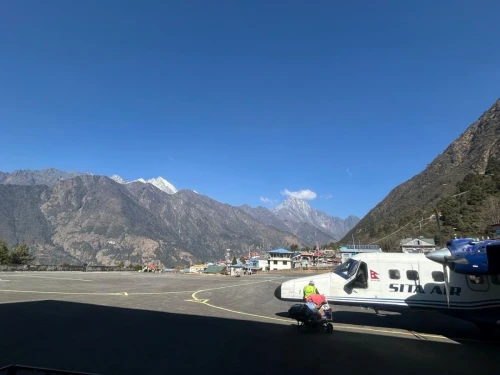Geographical Location and Borders of Nepal
Nepal is a landlocked nation in South Asia that is bordered to the north by China and to the south, east, and west by India. Stretching from the Ganges plains in the south to the Himalayan peaks in the north, Nepal is located between latitudes 26° and 31° N and longitudes 80° and 89° E.
With a total area of just 147,516 square kilometres, Nepal is smaller than many other nations but has a remarkably varied topography and climate. Deep river valleys, rolling hills, fertile plains, dense forests, and snow-capped mountains are just a few of Nepal's diverse natural landscapes, even though the country lacks direct access to the sea.
Mount Everest and other high peaks create a natural border with Tibet along the Himalayan mountain range, which forms its northern border. Similarly, the southern terai plains form a gentle, warm border with India, which facilitates trade and overland travel.
As for the main border crossings with neighbouring India, traders, tourists, and pilgrims regularly use Sunauli (Bhairahawa), Raxaul (Birgunj), Kakarbhitta (Jhapa), and Nepalgunj.
Three Regions of Nepal – Himalayan, Hilly & Terai
The stunning topography of Nepal is separated into three primary regions, each of which offers a distinct climate, landscape, history, culture, and travel experience. On top, the Himalayan region (north) spans the northern frontier and is home to giant peaks such as Mount Everest, Annapurna, Dhaulagiri, Manaslu, and Langtang Lirung.
Famous trekking routes like the Everest Base Camp Trek, Annapurna Circuit Trek, Langtang Valley Trek, Upper Mustang, and Manaslu Circuit can be found in this area, which is also referred to as the trekkers' and mountaineers' paradise.
Additionally, you can instantly book one of our expertly designed travel packages in Nepal's mountain region if you're interested in any of these treks.
The hilly region (Central Nepal) serves as the country's cultural and population heart, as well as a repository for important national histories. Among the key locations in the hilly region are the Kathmandu Valley, Pokhara, Bandipur, Gorkha, and Dhulikhel.
With its verdant hills, picturesque lakes, terraced farms, lovely flowers, and forests, it's the perfect place for quick hikes, cultural tours, and adventure sports like mountain biking, paragliding, and ziplining.
Additionally, the climate in the hilly region is milder than in other parts of Nepal, with the terai being hotter and the mountains being colder all year round. This may also be the reason why the majority of people live in the hilly region.
Around India's borders lie the fertile, level plains of the terai region (south), which is well-known for its jungle's abundance of wildlife and tropical climate.
Chitwan National Park and Bardiya National Park, located in the terai region, are well-known for safaris, bird watching, and jungle lodges where visitors can see elephants, one-horned rhinos, Bengal tigers, and many other unique creatures.
Together, these three regions characterise Nepal's distinct topography, where nature, adventure, and spirituality coexist harmoniously. Additionally, Nepal's small size makes it possible for tourists to experience three different worlds in a single day, which is uncommon in other parts of the world.
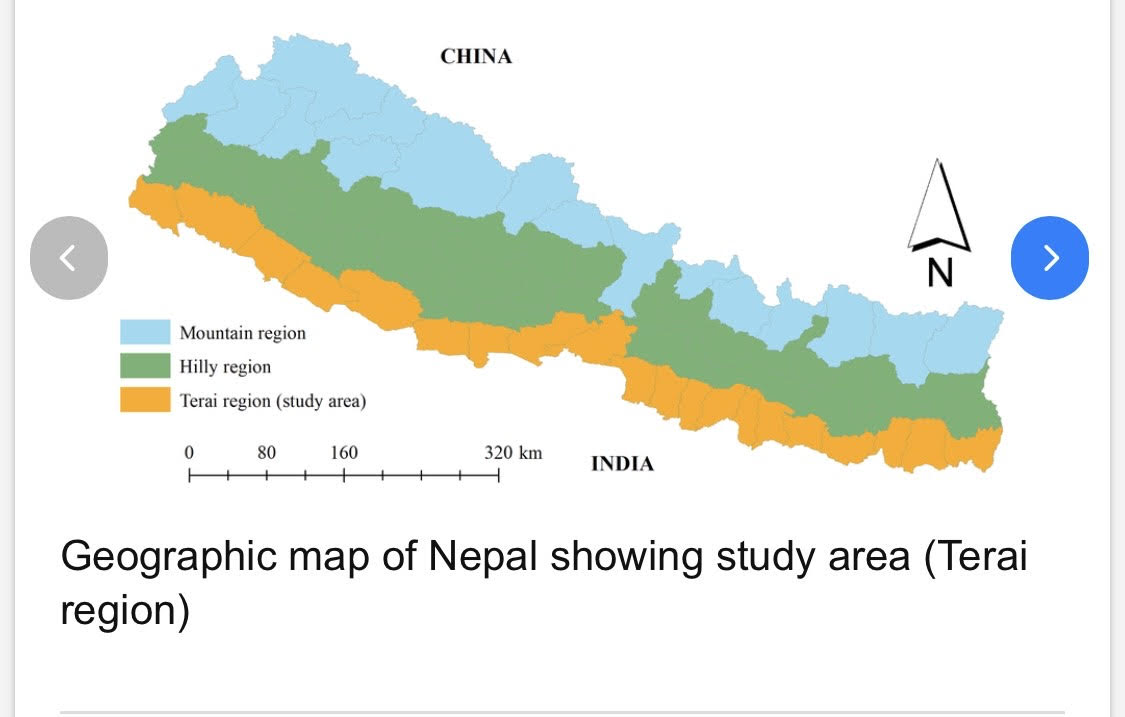
Nepal’s Climate and Natural Diversity
Since Nepal's topography and altitude range from tropical to alpine, its climate differs significantly from that of other nations. As we learnt in the previous paragraph, the climate is alpine and arctic in the high Himalayas, temperate in the hilly region, and tropical in the southern Terai plains.
The following table lists the four main seasons that the nation experiences throughout the year:
| Seasons | Characteristics |
| Spring (March - May) | Blooming Flowers, Clear Skies, Ideal for Trekking conditions |
| Summer/Monsoon (June - August) | Heavy Rainfall, Lush Greenery, River Rafting opportunities |
| Autumn (September - November) | Clear Skies, Stable Weather, Perfect for Trekking |
| Winter (December - February) | Snow in High-Altitude regions, Crisp Air, Fewer crowds in destinations |
In addition, Nepal has 10 UNESCO World Heritage Sites, which reflect the country's natural and cultural diversity. These include Lumbini, Sagarmatha National Park, and the monuments of the Kathmandu Valley.
With its remarkable biodiversity, which includes alpine meadows, tropical jungles, subtropical forests, and glacial landscapes, Nepal is a popular destination for adventure seekers.
Visitors from all over the world can take advantage of high-altitude treks, rafting in Trishuli, paragliding in Pokhara, and jungle safaris in Chitwan and Bardiya. Because of the natural diversity, you as a traveller will undoubtedly discover something remarkable, as it caters to all kinds of travellers, from mountaineers to those who enjoy wildlife.
Fascinatingly, Nepal's varied landscapes and climate also sustain a wealth of wildlife, including hundreds of different bird species, rhinos, tigers, snow leopards, and red pandas. Because of its climate, biodiversity, and landscapes, Nepal is a year-round destination that provides exceptional experiences throughout the year.
Cultural and Spiritual Heart of Nepal
Hinduism and Buddhism coexist peacefully in Nepal, the land of the Himalayas, a unique cultural melting pot that influences the country's daily life and holiday customs. Christianity, Islam, and Kirat are some of the other major religions in addition to these.
Even though there are many different religions in this tiny nation, everyone is free to practise their own beliefs and coexist peacefully.
The main celebrations in Nepal that showcase this dynamic culture are:
| Dashain | It is Nepal's longest and most widely celebrated Hindu festival. It represents the victory of good over evil. |
| Tihar | In this festival of lights, animals, siblings, and various deities are honoured. |
| Holi | This is the vibrant spring festival, which is joyfully and colourfully celebrated. |
| Buddha Jayanti | Commemorating the birth of Lord Buddha in Lumbini, a spiritual pilgrimage for Buddhists worldwide. |
Alongside these, there are numerous other regional celebrations as well as particular group festivals that are enthusiastically observed.
Additionally, Nepal is home to numerous historic temples and stupas that draw both pilgrims and tourists. The most well-known of these in Kathmandu are:
- Pashupatinath Temple
- Boudhanath Stupa
- Swayambhunath
These sacred locations contain spiritual energy and centuries of history, which are extremely revered.
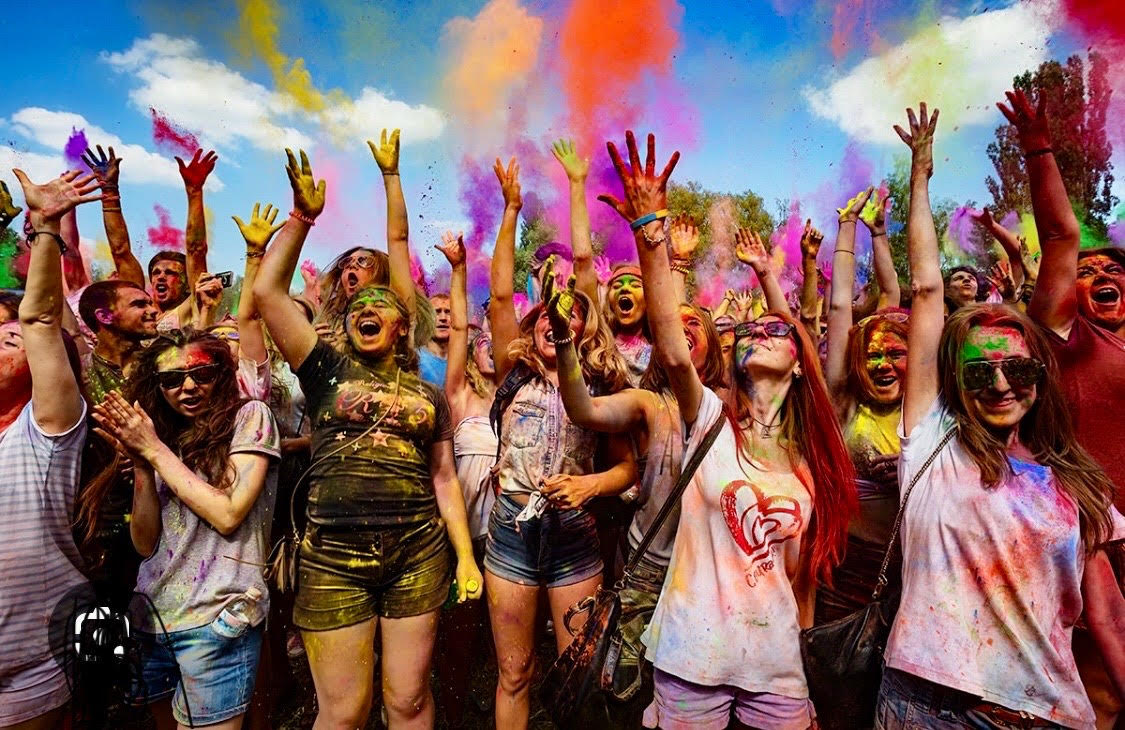
Visitors can get a glimpse of historic Nepali life in traditional cities like Bhaktapur and Patan, which feature centuries-old craftsmanship, cobblestone streets, and authentic Newari architecture.
Similar to this, different places provide you with different cultures and insights. For example, the Sherpa culture in the Khumbu region, the Gurung and Magar culture in the Annapurna Base Camp Trek, and the Tamang culture in the Langtang Trek.
When visiting Nepal, you will have the opportunity to immerse yourself in the local culture through homestays, community hikes, and workshops where you can take part in customs, traditional cooking, and handicraft creation.
When tourists depart Nepal, they have a greater appreciation for Himalayan spirituality and ageless customs because of the country's rich fusion of festivals, rituals, architecture, and traditional lifestyles.
Nepal's Top Destinations for Trekking and Adventure
If you have read this far, you have probably already learnt about Nepal's natural beauty and the captivating Himalayas. And, yes, Nepal is a world-class trekking and adventure destination, with routes and activities suitable for beginners, experienced trekkers, and extreme adventurers.
Some of the most well-liked trekking routes and popular destinations in Nepal are as follows:
Everest Base Camp Trek
One of the most iconic treks in the world, the EBC Trek leads you to the base of the highest mountain in the world. This trek, which passes through the Khumbu Valley and Sherpa villages, is full of challenges and stunning Himalayan scenery. Additionally, Mount Glory Treks offers a range of Everest Base Camp Trek packages with varying itineraries and price points. You can select the package of your choice and start your EBC adventure right away.
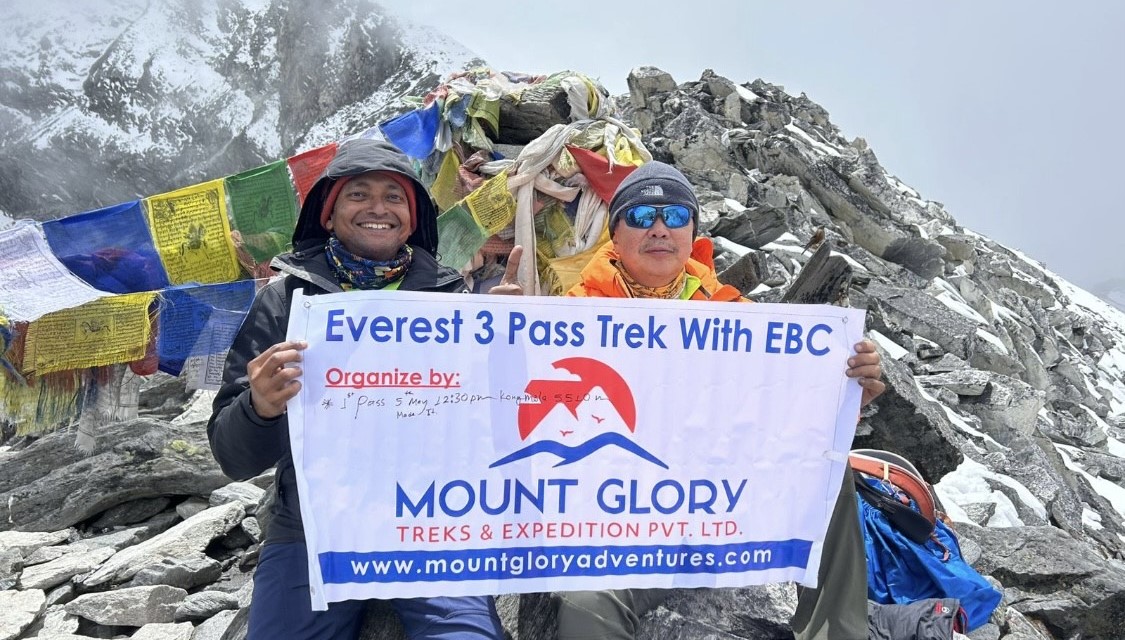
Annapurna Base Camp Trek
Annapurna Base Camp Trek, 10 Days from Kathmandu to Kathmandu, is one of Nepal’s most scenic adventures, offering breathtaking Himalayan views and rich cultural experiences. This 10-day Annapurna Base Camp Trek itinerary includes transportation from Kathmandu to Pokhara, guided trekking with professional Sherpa guides, and comfortable accommodation. The Annapurna Base Camp Trek cost is affordable, covering permits, meals, and expert support. This ABC Trek from Kathmandu is perfect for trekkers seeking a moderate challenge and stunning landscapes. Experience the beauty of Machhapuchhre, Annapurna I, and Gurung villages with Mount Glory Treks, your trusted Nepal trekking company.
Gokyo Lake Trek
Embark on the Gokyo Lake Trek – 12 a high altitude adventure with Mount Glory Treks and experience the untouched beauty of the Everest Region. This breathtaking trek takes you through Sherpa villages, scenic valleys, and the mesmerising turquoise Gokyo Lakes, offering spectacular views of Mt. Everest, Cho Oyu, and Makalu. Starting with an exciting Lukla flight, the journey blends natural splendour with rich Sherpa culture. Our experienced Sherpa guides ensure your safety and provide authentic local insights throughout the trek.
Annapurna Circuit Trek
The Annapurna Circuit Trek, which is the most popular among moderate hikers, is well-known for its varied terrain, which includes high mountain passes, terraced hills, and subtropical forests. Through the villages of Gurung and Thakali, the routes will immerse you in rich cultural experiences.
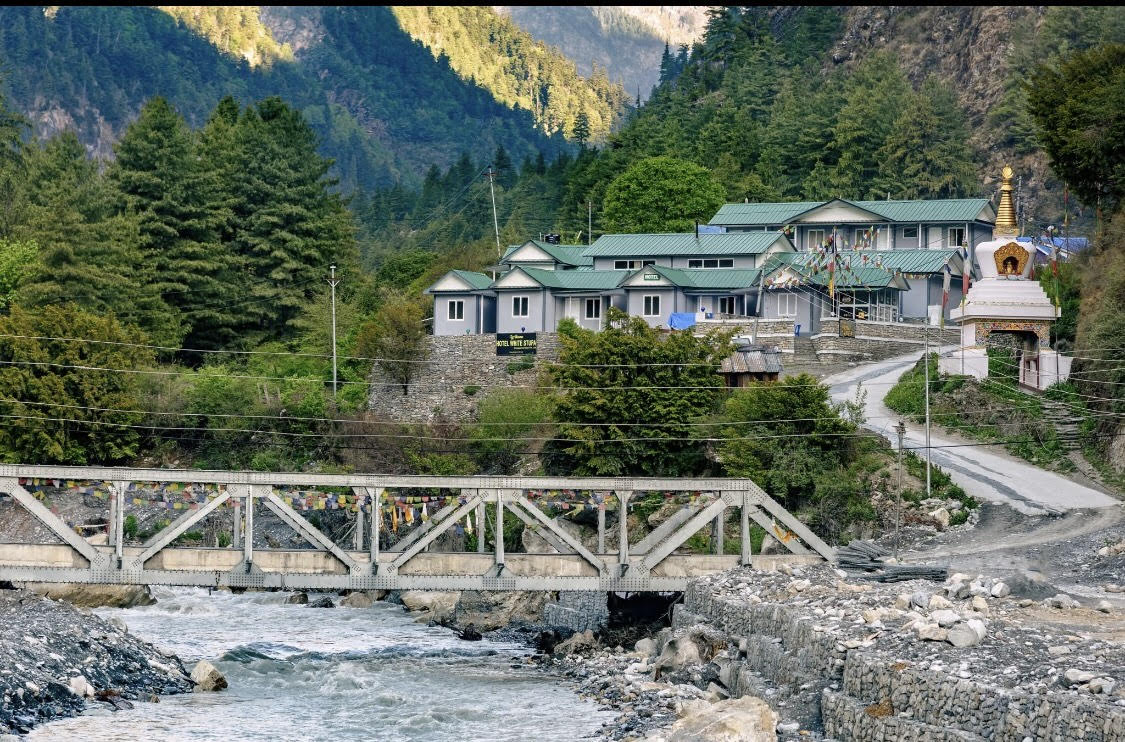
Langtang Valley Trek
This shorter Langtang trek offers beautiful scenery and up-close views of nearby peaks, and it is closer to Kathmandu, the country's capital. This trek is perfect for novice hikers and offers views of the Langtang Lirung and alpine meadows.
Mardi Himal Trek & Ghorepani Poon Hill
You can enjoy expansive sunrise views of the Machhapuchhre Peak and the Mardi Himal on this easy-to-modernly difficult trek. Additionally, this trek can be finished in a few days, saving you time while still providing you with a mountain experience.
Upper Mustang & Dolpo Treks
Trekking to the remote regions of Nepal via the Upper Mustang and Dolpo routes takes you off the usual route. You will discover the distinctive Tibetan culture, caves, desert vistas, and Himalayan way of life as you travel through the ancient Himalayan kingdoms on this enchanted adventure.
Kanchenjunga Circuit Trek
The Kanchenjunga Circuit Trek is an off-the-beaten-trail, high-altitude restricted trek in eastern Nepal that requires a special permit. This 18-day itinerary from Kathmandu to Kathmandu is organised by Mount Glory Treks, led by experienced Sherpa guides and tailored for trekkers seeking remote scenery, pristine alpine valleys, and authentic mountain culture. Estimated cost: $2,200 (per person) — includes permits, guide, accommodation on trek, and most meals.
Manaslu Circuit Trek
There are many glacial vistas, suspension bridges, lakes, up-close mountain views, and isolated villages along this difficult route. Experienced hikers who are up for a demanding adventure are increasingly choosing the 13-day Manaslu Circuit Trek in Nepal.
For your information, our extensive selection of travel packages, which we have expertly curated with years of experience and knowledge, includes all of these popular trekking destinations in Nepal, as well as other trekking destinations.
Additionally, the travel package can be tailored to your preferences, so don't hesitate any longer and book your trek through Nepal's Himalayas.
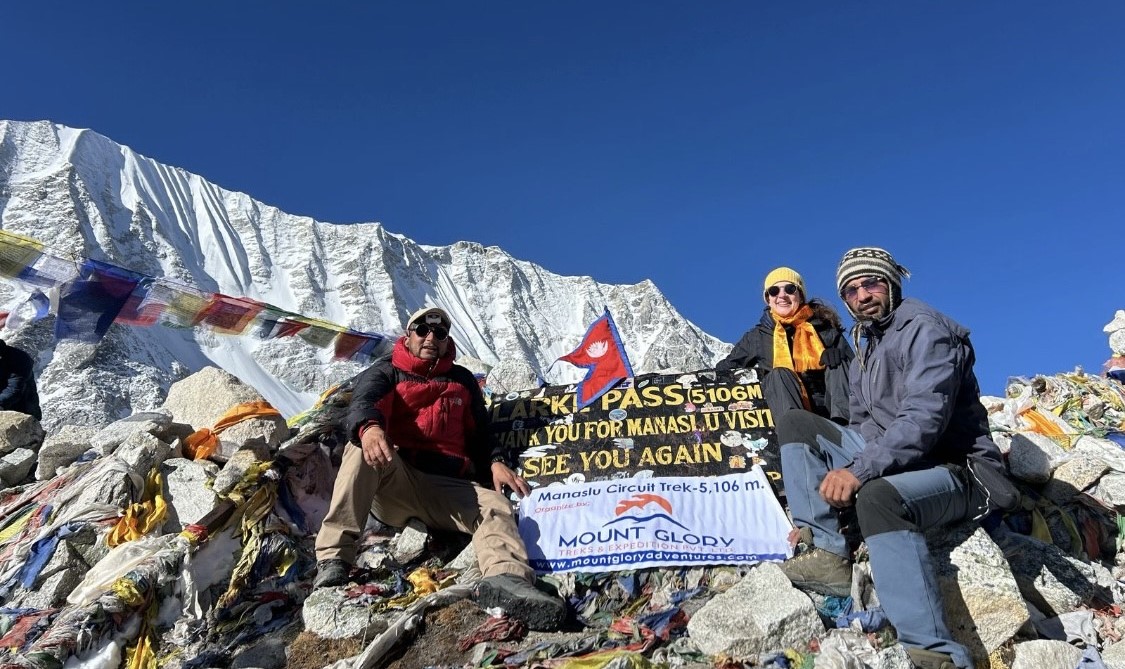
Beyond trekking, adventure activities in Nepal include:
- Bungee Jumping
- White-water Rafting
- Paragliding
- Mountain Biking
- Ultralight Flights and Scenic Mountain Flights
Quick Facts about Nepal
Continent: Asia
Region: South Asia
Capital City: Kathmandu
Currency: Nepalese Rupee (NPR)
Official Language: Nepali (English widely spoken in tourist areas)
Highest Point: Mount Everest (8,848.86 m).
Lowest Point: Kechana Kalan (59 m) in Jhapa District, eastern Terai.
Area: Approximately 147,516 square kilometres.
Population: Around 30 million people.
Major Airports:
- Tribhuvan International Airport (Kathmandu) – main international gateway.
- Pokhara International Airport – gateway to the Annapurna region.
- Gautam Buddha International Airport (Lumbini) – an access point for pilgrims visiting the birthplace of Buddha.
Best Season to Visit: Autumn (Sept–Nov) and Spring (Mar–May)
Visa: Visa on arrival for most nationalities; available at Kathmandu and border entry points.
Time Zone: Nepal Standard Time (UTC +5:45)
Electric Plug Type: Type C, D, and M (220V, 50Hz).
Religion: Predominantly Hindu with a significant Buddhist minority.
There are ten UNESCO World Heritage Sites in Nepal, including Lumbini, Sagarmatha National Park, and the Kathmandu Valley.
Nepal has over 870 bird species and more than 100 ecosystems, ranging from tropical jungles to alpine meadows.
The main tourist activities are trekking, mountain climbing, jungle safaris, paragliding, rafting, heritage tours, and cultural exploration.
Popular tourist destinations include Kathmandu, Pokhara, Chitwan, Lumbini, the Everest Region, and Mustang.
Local Greeting: “Namaste”
Fun Fact: Nepal has two overlapping triangles that represent the Himalayas, making it the only nation in the world with a non-rectangular flag.
In Conclusion
Nepal’s unique location gives it an unparalleled combination of natural beauty and cultural richness. The fact that Nepal has something to offer all kinds of tourists is the primary factor keeping it at the top of people's lists.
When it comes to providing travellers with safe travel, warm hospitality, and limitless opportunities for exploration and photography, Nepalis are known for their generosity.
Nepal is the best place to go for adventure travel, cultural discovery, and spiritual development, making it a must-see in South Asia and, to be honest, the entire world.
Travellers leave Nepal with lifelong memories from each trek, visit, safari, or other trip, demonstrating why Nepal is the real gem of the Himalayas.
With a wide range of destinations and trip types, you can book your ideal trek right now and experience the stunning mountains, lively culture, and life-changing events for yourself.
Frequently Asked Questions
1: In which part of Asia is Nepal located?
Situated between China's Tibet region to the north and India to the south, east, and west, Nepal is a landlocked nation in South Asia.
2: What is the best time to visit Nepal?
For trekking, sightseeing, and adventure activities, the best seasons are spring (March–May) and autumn (September–November).
3: What are the main regions of Nepal?
Nepal is divided into three regions: Himalayan (north), hilly (central), and Terai (south).
4: Which trekking routes are most popular in Nepal?
Everest Base Camp, Annapurna Circuit, Langtang Valley, Manaslu Circuit, Upper Mustang, and Mardi Himal are among the well-liked treks.
5: What is Nepal famous for?
Nepal is well-known for its Himalayan mountains, which include Mount Everest, as well as its rich cultural heritage, Buddhist and Hindu traditions, trekking, and adventure travel.
6: Do I need a visa to visit Nepal?
Yes, the majority of nationalities can obtain a visa at the border crossings or at the airport in Kathmandu.
7: What currency is used in Nepal?
The official currency is the Nepalese Rupee (NPR).
8: What languages are spoken in Nepal?
Although Nepali is the official language, most people in tourist areas speak English.
10: What are Nepal’s must-visit cities and destinations?
The Everest and Annapurna regions, as well as Kathmandu, Pokhara, Chitwan, Lumbini, Bhaktapur, and Patan, are important travel destinations.
11: What festivals are celebrated in Nepal?
Dashain, Tihar, Holi, and Buddha Jayanti are important celebrations that highlight Buddhist and Hindu customs.
12: Is Nepal safe for tourists?
Yes, with friendly locals and well-run trekking and tour services, Nepal is regarded as a safe place for tourists.
13: Can I go on wildlife safaris in Nepal?
Yes, go on safari in Chitwan and Bardia National Parks to see tigers, rhinos, elephants, and a variety of birds.
14: What adventure sports can I do in Nepal?
White-water rafting, mountain biking, bungee jumping, paragliding, and mountain flights over the Himalayas are all available in Nepal.
15: How do I get to Nepal from other countries?
There are flights from India, China, Southeast Asia, and the Middle East to Nepal via Tribhuvan International Airport in Kathmandu.
16: Why is Nepal called the “Roof of the World”?
With eight of the fourteen highest peaks in the world, including Mount Everest, Nepal is the ideal place to visit in the Himalayas.
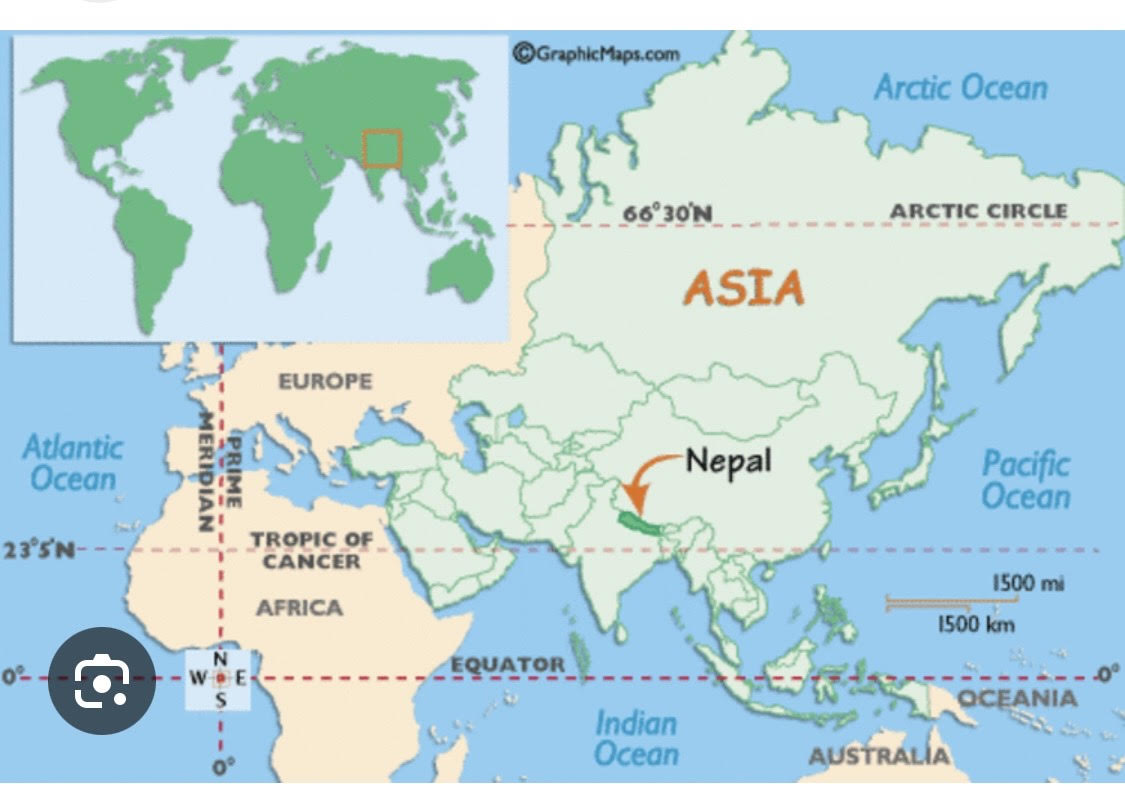


 4 reviews
4 reviews






